In our family photo albums one of the nicest photos of my wife as a baby, shows her all dressed up, being held by a smiling man in a uniform.
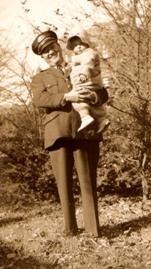 | photo of Grandpa Franz and his granddaughter-Click for larger view |
Surrounding them are trees, dense shrubbery, lush grass – all the aspects of a lovely park. But when asked where it was taken, she says “at Green-Wood Cemetery” where her grandfather – the man in the uniform, was a guard and visitor guide back in the 1940s.
The history of cemeteries goes back thousands of years – as long as humans have been burying or otherwise giving special handling to their dead. Various religious beliefs have led to very distinctive practices, ranging from the eternal pyramids of the Egyptian pharaohs to the frail burial platforms of some native peoples, both rather grim.
 | Early-style graveyard, neglected graveyard-Click for larger view |
And cemeteries in Europe, and in America after its first settlement, continued to be rather plain, grim places, filled with stone slabs, suitable for mourning (and looking for ghosts).
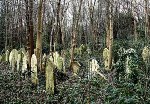 |
But in the 19th and early 20th centuries, as part of a particular esthetic that arose in that period in the United States, some cemeteries were developed to be places of beauty both artistic and horticultural – public gardens before public parks became common, rivaling parks after they came along, and even serving as alternative public parks for many. Most American cities of any size have at least one older cemetery of this sort and some are so extraordinary as to be nationally, or at least regionally, famous.
Mt. Auburn Cemetery in Watertown, Massachusetts (a Boston suburb), founded in 1831, was the first example. At 174 acres it is only medium-sized for a garden cemetery, but is outstanding for its landscaping, art, and famous burials. Mt. Auburn, designed by Henry Alexander Scammell Dearborn, is credited as the beginning of the entire American public parks and gardens movement and it set the style for several other landmark American cemeteries, including Philadelphia’s Laurel Hill Cemetery (1836), Green-Wood Cemetery in Brooklyn (1838), Green Mount Cemetery in Baltimore (1838), and Forest Hills Cemetery, also in Boston (1848). Collectively these provided the link between 18th-century English landscape gardening and Frederick Law Olmsted’s Central Park in New York City (1850).
Guidebooks were published to Mt. Auburn, strict rules established about the size and style of grave markers. Above all, beautiful landscaping was designed, planted, and carefully tended. Today Mt. Auburn’s collection of over 5,500 trees of nearly 700 species and varieties and thousands of well-kept shrubs and herbaceous plants decorates the hills, ponds, woodlands, clearings, and more than 10 miles of roads. Notable burials include William Ellery Channing, John Ciardi, Charles Bulfinch, Dorothea Dix, Mary Baker Eddy, Buckminster Fuller, Winslow Homer.
Three photos of Mt. Auburn below:
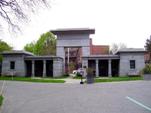 | photos of Mt. Auburn 1. Egyptian Revival Entrance Gate Click for larger view |
 | photos of Mt. Auburn 2. Civil War Monument Click for larger view |
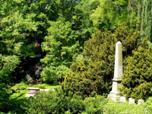 | photos of Mt. Auburn 3. Some of the beautiful Mt.Auburn plantins and monuments Click for larger view |
Forest Hills in Jamaica Plain, Massachusetts, is larger than Mt. Auburn at 225 acres and similarly carefully landscaped. Famous burials include e. e. cummings, William Lloyd Garrison, Edward Everett Hale, Kahlil Gibran, and Eugene O’Neill. The gateway, instead of Egyptian like Mt. Auburn, is in the far more typical neo-gothic style.
Two photos of Forest Hills below:
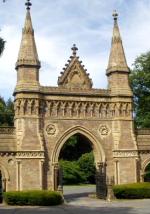 | photos of forest Hills 1. Forest Hills Gateway-Click for larger view |
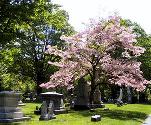 | photos of forest Hills 2. Flowering tree at Forest Hills-Click for larger view |
Laurel Hill in Philadelphia, though smaller than Mt. Auburn, is noted for its remarkable collection of architectural and sculptural mausoleums. More than 33,000 markers and monuments fill the hillside cemetery. Famous burials include Civil War General George Gordon Meade; Owen Wister, novelist and author of The Virginian; and Henry Deringer, the gunsmith.
Four photos of Laurel Hill below:
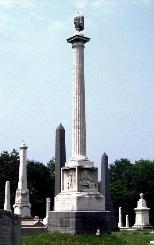 | photos of Laurel Hills 1. Cluster of monuments at Laurel Hills-Click for larger view |
 | photos of Laurel Hills 2. Mausoleums at Laurel Hills-Click for larger view |
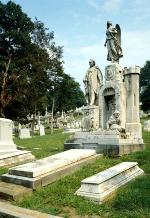 | photos of Laurel Hills 3. A Cemetery Monument at Laurel Hills-Click for larger view |
 | photos of Laurel Hills 4. Laurel Hills Cemetery Tomb-Click for larger view |
Green Mount Cemetery in Baltimore is perhaps less impressive for its landscaping, but remarkable for the artwork included among its monuments. Among its famous burials are John Wilkes Booth and two other conspirators in the Lincoln assassination. (It’s a custom to leave Lincoln pennies on the graves of the assassins.) Also Elizabeth Patterson Bonaparte, Napoleon’s sister in law; Johns Hopkins the philanthropist; and Sidney Lanier the poet.
Four photos of Green Mount below:
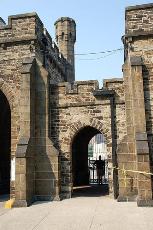 | photos from Green Mount 1. Green Mount Cemetery-entrance Gate-Click for larger view |
 | photos from Green Mount 2. Riggs Monument at Green Mount-Click for larger view |
 | photos from Green Mount 3. Bronze Mourner at Green Mount-Click for larger view |
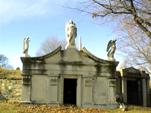 | photos from Green Mount 4. John Weaver mausoleum at Green Mount-Click for larger view |
But the giant of all the early garden cemeteries is Green-Wood Cemetery in Brooklyn, New York, where my wife’s grandpa worked. At 478 acres and with approximately 600,000 graves, it is in its own class. Almost as large as nearby Prospect Park, at one time Green-Wood was nearly as popular as a place for city families to spend a pleasant weekend outing. Grandpa Franz was for years a security guard and greeter there, who would help visitors find what they were looking for and make sure they behaved themselves. My father-in-law as a young man worked with his dad at Green-Wood as a groundskeeper.
My wife remembers the place fondly as being totally different from the generally gloomy, crowded, burial grounds more typical of New York City cemeteries. Instead, Green-Wood was filled with trees, shrubbery, and flowers. The rugged glacial moraine setting rises to as much as 200 feet above the harbor that lies at the foot of the hill on which Green-Wood is located. The gothic revival entrance gate is a well-known landmark on Brooklyn’s Fifth Avenue and often reproduced in books about the history of architecture as a quintessential example of the gothic revival style. Famous burials at Green-wood are legion and range from DeWitt Clinton to Leonard Bernstein. The cemetery has even figured as a setting (for the climactic scene) in a detective novel: "Lawrence Block’s A Walk Among the Tombstones."
Three photos of Green-Wood cemetery below:
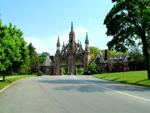 | photos from Green Wood 1. Entrance gate at Green Wood-Click for larger view |
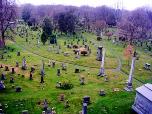 | photos from Green Wood 2. Vista at Green Wood-Click for larger view |
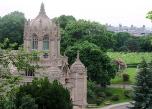 | photos from Green Wood 3. Chapel at Green Wood-Click for larger view |
Many, many more garden cemeteries were developed as the country exploded with prosperity and confidence following the Civil War. Some are as impressive as the pioneering ones described. Of the ones from more modern times, perhaps the most famous might be Forest Lawn Cemetery in Los Angeles, memorialized as “Whispering Glades” in the Evelyn Waugh novel (later made into a movie) The Loved One. Forest Lawn is actually a series of cemeteries in the Los Angeles area, originating with the one in Glendale, and later ones in Hollywood Hills and other locations, designed entirely as parks with myriads of often spectacular artworks and lavish landscaping, but unobtrusive grave markers. The Forest Lawn concept, originated in the early 20th century, has dominated American cemetery design for decades now, and will perhaps only be supplanted as more and more people opt for cremation in the face of skyrocketing burial costs and urban land becomes prohibitively expensive.
Two photos of Forest Lawn below:
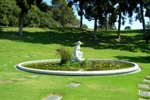 | photos from Forest Lawn 1. Forest Lawn, Glendale-Click for larger view |
But whatever one may think about the extravagances and frequently blatant one-upmanship that garden cemeteries came to be associated with, many of them remain beautiful places filled with remarkable art and lush landscaping – and is that such a bad thing? |






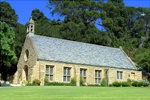
My great grandfather came here from Ireland in the 1840's (he didn't have my garandfather until almost 70). He settled in Brooklyn. We apparently have(had) family buried in Greenwood. Hope to get there and check it out. Who knows, perhaps cousins of mine knew your wife's family.
ReplyDelete